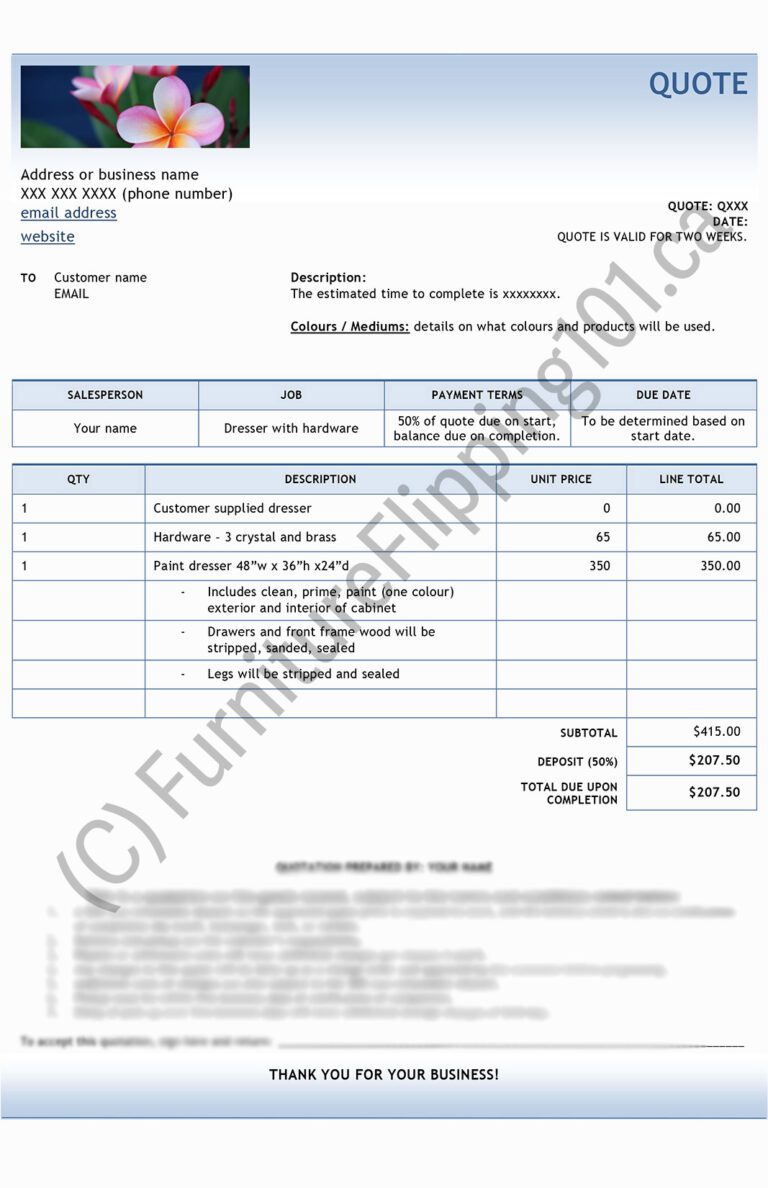You’ve found a hot sales lead and priced out what you will charge. Now it’s time to bring home the sale. Don’t let the opportunity slip away! Here’s how to professionally and quickly create a quote for refinishing furniture.
Why you need to create a quote for refinishing furniture
A quote is a formal, legally enforceable document once accepted by the client. Professional refinishers create a quote for refinishing furniture, which outlines the work they will perform, the products they will use, the timelines the customer can expect, and (optionally) the contract’s terms and conditions. A quote instills confidence in your business and makes your business stand apart from someone who doesn’t provide a written quote for refinishing furniture.
If you wish, you can create a separate contract with your terms and conditions, but I find it keeps it simple if the contract’s terms and conditions are on the quote and provide room for the customer’s signature and date signed.
When you provide a quote for refinishing furniture, you tell the prospective customer that you will honour that price for those products and services for a fixed period. After that period expires, that quote for refinishing furniture is no longer valid, and a new quote needs to be issued.

This deadline serves three purposes:
1. It adds pressure on the prospective customer to make a decision,
2. It covers you in case the price of materials goes up, and
3. If your circumstances change and you can no longer provide the quoted services, you can decline.
So choose this deadline with some thought.
A quote covers you if things do not go smoothly. If the customer is unhappy with a colour choice, you can point to the signed document and the details you provided that outlined the colours used. Or, if additional damages weren’t visible in the supplied photographs or upon initial inspection, you could point out the change order clause for unforeseen repairs. Always include a change order clause in a quote for refinishing furniture – they will save the day in many ways, from a colour change to repairs or changes to the project’s scope, like adding a transfer or a different style of hardware.
There are many examples I can give, and I am constantly tweaking my document’s terms and conditions to include another issue that comes up. How long will you store a piece of furniture once completed? Do you accept personal cheques? For as many commissioned pieces I do, I am always running into another point to clarify. (Who still uses personal cheques? – apparently, people do…).
Document names and why they matter
Before we get into the details of how to create a quote for furniture refinishing, let’s look at some different document terms.
Maybe you’ve heard many different names for a quote and wonder what the difference is between the terms. As a bookkeeper, I can tell you it is essential to use the correct terms. It looks unprofessional if you call documents by the wrong name, giving the wrong impression to your potential client.
Work Orders and Invoices
I’ve seen a few blog posts using terms like work order or invoice instead of quote. Neither of these is a substitute for the term quote or contract. A work order means the customer has agreed to the work and you are assigning the work internally or to another entity, and an invoice means the work is complete and you are offering the customer payment terms. It is rare to use invoices in our line of work – most payments are due upon completion. Because neither of these documents serves the same purpose as a quote for refinishing furniture, you should not use these terms.
Receipts
A receipt is a document you provide that provides the customer with proof of payment. You might issue a receipt for the money the customer paid, but that, too, is rare; if the customer uses a trackable, electronic payment method that works as a receipt.

What to include on a receipt
If your client requests a receipt, the receipt for money received should include the date, the form of payment (cash, cheque, credit card, etransfer, etc.), the quote number or service description to which it applies, whether the balance is paid in full or it is a deposit, and a signature (or business details) and tax number (if collected). You can write a receipt out in a receipt book with a carbon copy or use an electronic version.
Keep track of any payments and the date received. See the video above on how to record a sale in your bookkeeping software.
Estimates
An estimate is a ballpark amount. Usually, new refinishers give estimates – they aren’t sure how many hours or how much paint they will need. Completing work with only an estimate leaves you and the customer vulnerable to problems. Often these estimates are verbal too. That puts the entire transaction at risk of someone being unhappy.

I’ve seen a lot of posts on social media where the refinisher is in a dilemma. They provided an estimate, and then the materials used or the time it took to do the work was nowhere close to what they estimated. Now, the customer wants to hold them to that too-low price (rarely do you see a post about overestimating), or they are trying to figure out a way to break it to the customer and ask for more money. See the previous article on how to price custom refinished furniture.
Avoid ambiguity and stress and do up a proper quote. If the piece is significantly damaged or complex and you cannot provide an exact price for the customer, work in stages and get each one approved before moving on to the next. And, while it can be a bit intimidating to create quotes and have them signed, it is always best to have everything in writing. At the very least, use an electronic method of communication – email, messenger, text – something you can refer back to and say, ‘you agreed to this here and here.’
Change Orders
Sometimes you try to be as thorough as possible but still miss some damage, especially if you quoted from photos. You can issue a change order for alterations to the originally agreed-upon details. As mentioned earlier, a change order can save the day. If the customer wants a different colour than agreed to, then use a change order (and an additional cost).

Deposits and Retainers
When your quote is accepted, it is good business practice to take a non-refundable deposit. Should your client decide not to pay for your services, the deposit covers some of your incurred costs. This is not legal advice, so please consult an expert on the legal ramifications of taking someone’s money for a service and not fulfilling the contract.
Here is my view on how a deposit works. There may be no need to say ‘non-refundable’ deposit since it is implied in the term deposit, but stating non-refundable provides clarity. The client must know they are committed to you doing the work once they drop off the piece or pieces with the signed quote and contract. If, for any reason, they stop you during the process, you can keep the deposit to cover your time and materials to date.
If you determine at a point that you are unable to finish the job – maybe it is too big for your skills, or maybe life comes up, then I would say you should return the deposit, especially if you have started work on the piece and the client will need to pay someone to finish what you started. If the client doesn’t like a colour or technique, issue a change order to adapt to what they want, if feasible. Remember, they agreed to the process and colours by signing the contract and providing the deposit but those ideas can look different on a piece than in real life. Work with your clients to keep them happy, where reasonable.
When the piece or pieces are complete, the balance is due. The client should not expect to take the piece or pieces home without paying the remaining amount due on the contract and any change orders. Please do not allow them to do this, or you may not get paid in full. I’ve also added a clause that I charge a storage fee of $10 per day after five business days from notification of completion (verbal, written, or electronic). Some people will delay pickup, taking up your workspace where you need to work on new projects.
A retainer is like a deposit but is used to hold your services. If you issue a few accepted quotes, you must schedule the work. The client signs the quote and pays a retainer to hold a spot. You apply this amount against the balance due in the same way as you would a deposit. The retainer would be non-refundable as well, should the person cancel. If you cannot fulfil the quote, you would return the retainer.

Creating a Quote for Refinishing Furniture
Okay, now that we’ve covered the terms you need to know to create a quote for refinishing furniture, let’s look at how to provide a quote for refinishing furniture.
You have determined the price and are ready to provide your potential client with a quote for refinishing furniture in writing. This document will help them understand the costs, services, and products you agree to provide. When potential customers see the details, it will build trust and rapport. Remember that quotes take considerable time and are often not accepted, so you should develop a system to streamline this process.
I include terms and conditions – the contract portion – in my quote. If the customer agrees to the terms and conditions and details of the work, they sign and date the document and return it with a 50% non-refundable deposit. Students in the Business Management course receive a copy of my quote for their use, plus a copy of my pricing guidelines for reference.
For non-students, you can use Microsoft Word to create and modify a free template, as noted below.
Quote for Refinishing Furniture by Time and Materials OR By Item
In the previous article, you determined whether you would price by time and materials or if you would price by the furniture item. Now enter your pricing using your preferred method. My preference is to price by item.
I use my pricing guideline and enter the details from it – for example, 42″ wood table, base price, includes prep, prime/strip, paint/stain, seal (I edit to match the job). I enter the quantity and unit price, and line total.
If you provide a quote by time and materials, decide if you will break those down in detail or not – I suggest the less detail, the better. Say you quote four hours and $75 in materials (don’t forget shop supplies). The person reading the quote might think you are overcharging them for the time it takes or the materials used. If, instead, you quote the piece of furniture and the details like prep, prime, paint, and seal one colour for $175; they may think that is a good price. Or, they might view things the opposite way – there isn’t a right or wrong way, per se, but I prefer pricing by item.
The Different Parts of a Quote for Refinishing Furniture
Using a quote template is one way I save time when creating a quote for refinishing furniture. The template is prefilled with all the information that doesn’t change from quote to quote, like my business logo, name, contact details, terms and conditions, and formatting.
- Document title: Quote
- Business contact information: your name, phone number, email address, and business address. Include a logo if you use one.
- Customer’s name and contact information: email address, phone number, and home address, if known. Include as much information as possible to ensure the quote is for that person only.
- Date of the quote
- Quote Number
- Quote validity period (I usually say two weeks from the date of the quote.)
- Description – use a general overview of what services you will perform. Include the following details:
- Estimated time to complete
- Estimated / available start date – This can be essential if you are busy and can’t start immediately.
- Colours, mediums, techniques (e.g. blended), hardware, etc. – include details in the additional details section
- Salesperson/Name of person providing the quote – your name or associate if more than one person quoting
- Job: Use a succinct description that helps you differentiate between jobs. This example is too plain.
- Payment terms and payment forms accepted
- Due date (job completion date) – I say to be determined (if accepted, then you can give them a more accurate date)
- Quote Summary: Quantity, Description, Unit Price, and Line Total. Include details what you will do: strip, sand, prime, paint, apply transfers or moulds, etc. The additional details section shows the products used and inspiration photos.
- Subtotal of the line items.
- Deposits and retainers
- Balance due upon completion: subtract the deposit and retainer from the subtotal
- Terms and Conditions – I include these on my quote so the client knows all the stipulations before they agree to my services.
- Signature line
- Date line
- Additional Details – see below.

Additional Details
At the end of the quote, include additional details like photographs of the products and their colours, client-provided photos, inspirational photographs, etc.
Any details that help the prospective customer envision their piece and how it will look once completed. You can add a second or third page if needed.
If using branded products, name the brand and the brand colours and products you will use. You might make your paint, have a custom colour mix, or use an oops colour and not wish to share that information. Be as accurate as possible; photograph a stir stick with a custom colour, for example.
Finalizing the Quote
Give a rough idea of how long you expect the job to take – and err on the side of caution. I used to say two weeks, and now, especially for larger jobs, I say six weeks. If I finish sooner, that is great; if not, I have some wiggle room. Things can come up like a back-ordered product – for one job, I ordered oxalic acid from Amazon and waited two weeks for it to arrive. I couldn’t move forward until I had it.
Once you are happy with the quote, make it into a pdf document and email it to the client. A PDF is harder to edit – you can use Adobe to password protect your document making changes much more difficult.
The customer may want changes – that is okay and perfectly normal. I use quote numbers like 150.0 and 150.1 to track any changes. **Make sure you save the new quote as a new document with the new number so you can track your changes.
If the sales lead approves the quote, they sign, date, and return it with the deposit and the furniture delivery.
Woo hoo! They are now a customer, and you are ready to start refinishing!

Last Thoughts
If you are completing a large commissioned job, you may want to break the payments down into progress payments. For example, if you are finishing an entire bedroom suite or dining room set, and you don’t have enough room to work on all of the pieces at once, you may work on one piece at a time, and bring each one to completion before the next piece. In that case, you could break the quote into parts with a deposit and payment due on each piece or require progress payments as you complete each piece.
Don’t be afraid to devise methods that cover your liabilities – if you take a large deposit on the whole job and they change their mind after two pieces, you may owe THEM money. By breaking it down to the work you have completed, you can reduce the risk to your business and set the customer at ease (they may not want to put out a big deposit upfront before any work has commenced).
If you have any questions or comments, let me know below. Check out the other two articles in this series on attracting sales leads for commissioned pieces and pricing custom refinished furniture.





